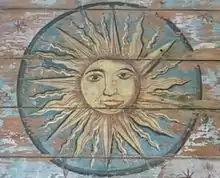The Sun in culture
The Sun, as the source of energy and light for life on Earth has been a central object in culture and religion since prehistory. Ritual solar worship has given rise to solar deities in theistic traditions throughout the world, and solar symbolism is ubiquitous. Apart from its immediate connection to light and warmth, the Sun is also important in timekeeping as the main indicator of the day and the year.[1]

Early history

The most punctual comprehension of the Sun was that of a plate in the sky, whose nearness over the skyline makes day and whose nonattendance causes night. In the Bronze Age, this comprehension was altered by accepting that the Sun is shipped over the sky in a pontoon or a chariot, and moved back to the spot of dawn during the night in the wake of going through the black market.
Numerous antiquated landmarks were developed with the death of the sun based year as a main priority; for instance, stone monuments precisely mark the late spring or winter solstice (the absolute most noticeable stone monuments are in Nabta Playa, Egypt; Mnajdra, Malta and at Stonehenge, England); Newgrange, an ancient human-manufactured mount in Ireland, was intended to recognize the winter solstice; the pyramid of El Castillo at Chichén Itzá in Mexico is intended to cast shadows looking like snakes climbing the pyramid at the vernal and pre-winter equinoxes.
Film
- Solar Crisis (1990)
- Sunshine (2007)
- The Wandering Earth (2019)
Television
- "Masks", a 1994 episode of Star Trek: The Next Generation in which the relationship between Masaka and Korgano is described as similar to the relationship between the Sun and the Moon
References
- Madanjeet Singh: The Sun: Symbol of Power and Life, Harry N Abram, 1993. ISBN 9780810938380
See also
| Wikimedia Commons has media related to Sun in art. |
| Wikimedia Commons has media related to Sun and moon. |
